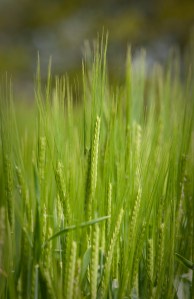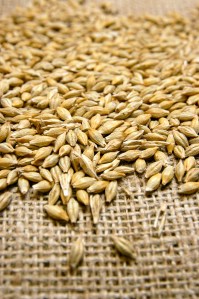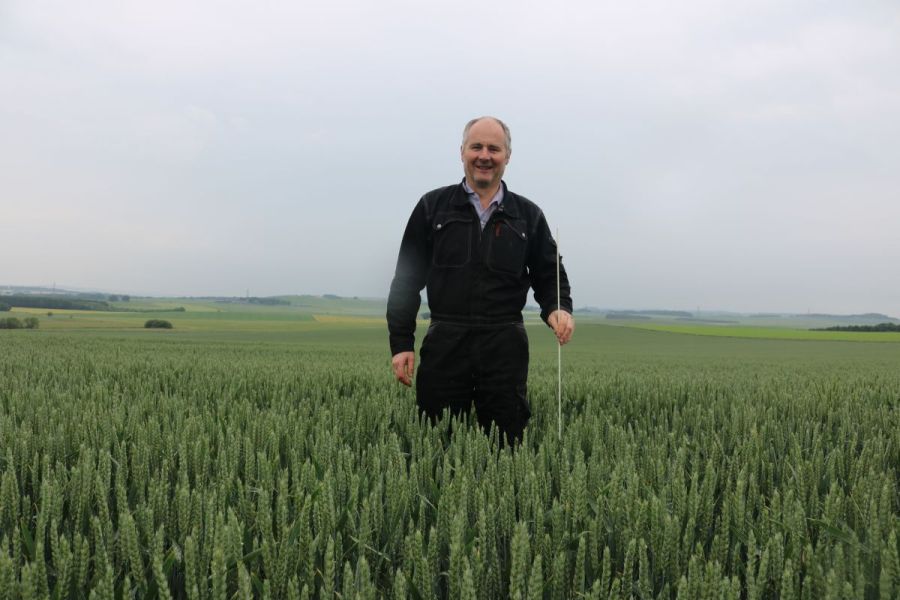Patience is the key to succeeding with both direct drilling and spring barley in Scotland, as CPM finds out when meeting David Fuller-Shapcott.
“Keeping on top of disease will also help delay any onset of ramularia.”
By Mike Abram
Conventional logic says direct drilling in Scotland is challenging. Doing it in high magnesium content clay soils is even more difficult. Adding in using low horsepower tractors on such soils some would say is absurd.

Spring barley forms approximately one-sixth of the cropped area at Sweethope Farm.
But David Fuller-Shapcott is on a mission to prove the naysayers wrong on his 369ha in the Scottish Borders, having last autumn bought a second-hand Horsch CO4 direct drill after a few seasons testing various drills.
His 25-40% heavy clay soils are what he describes as “sticky boot land”, although a combination of a drier February, albeit not as dry as in parts of England, and the improvements he has made in managing his soils, meant he was able to walk across his wettest fields without his boots becoming coated this February.
“We’re definitely winning the soil improvement battle,” he says. “We’re not yet in a position to say that our soils are really healthy and we can direct drill everything without an issue – I don’t believe that for one moment.
“But I do think we can direct drill our spring crops comfortably. It’s autumn crops, when it starts to get damp, that remain more of an issue.”
Patience is the key for spring crops, which is why he’s not panicking as a result of a much wetter March that has prevented any nitrogen being applied to his winter wheat, let alone starting spring barley drilling.
“Soil temperatures are sitting at 4.5⁰C, so I’ve not been in a desperate rush to do anything,” he says. “We have a saying up here that if soils are too cold to put your bare behind on, then it’s not time to drill yet.
“It’s all about soil temperature – I want it to be rising above 6⁰C and would prefer 8-9⁰C. Much to the annoyance of my staff, I do have a lot of patience and it is important.”

Cover crops or overwintered stubbles ahead of spring barley are grazed by a flying flock, before any remaining weeds are sprayed off with glyphosate in early April, explains David Fuller-Shapcott.
The other key factor for spring barley establishment is making sure the soils have dried out enough so drilling causes neither smearing or consolidation. “That includes on the turning headlands,” he says. “They need to be dry enough to withstand the weight of the tractor and drill.”
Everything is done with dual wheels on low horsepower tractors to minimise the footprint. “Our biggest tractor is 150hp, the 28m trailed sprayer is pulled by 115hp which most people think is absurd, while we use a 27-year-old, 85hp tractor with the rolls.
“The weight of machinery is the problem. Rutted tramlines on this soil with high magnesium content can have water sitting in them through harvest, and that’s just creating a permanent mess. I’d rather not do an autumn herbicide on winter cereals than make a mess.”
Spring barley forms approximately one-sixth of the cropped area on the farm in a rotation that starts with oilseed rape, spring oats sandwiched between two winter wheats, before spring barley and then winter barley as the entry back into OSR.
The alternation between winter and spring crops provides opportunities for either stale seedbeds, which are difficult between winter crops in Scotland, or over-wintered cover crops if the wheat is cleared early enough.
“Realistically cover cropping is a long shot because it’s usually too late to do it. Even last autumn, after a particularly early wheat harvest, we only managed to get one field in.”

Diablo is grown for distilling usage for specific end users, while Golden Promise is grown primarily for specialist brewing.
Cover cropping also requires the previous wheat crops to receive an autumn herbicide rather than a spring mesosulfuron-containing product, as the latter’s activity will impact on cover crop establishment success, he points out.
“Part of my switch to direct drilling is the aspiration that autumn herbicides will go on. It opens up the prospect of following the harvested winter wheat with a cover crop safely, or possibly flying a cover crop into the standing wheat crop.”
That would potentially extend the tight window for cover crops by around a month, he says.
Cover crops or overwintered stubbles ahead of spring barley are grazed by a flying flock, before any remaining weeds are sprayed off with glyphosate in early April. Base phosphorus and potassium fertiliser and around half of the crop’s nitrogen requirements are applied 7-10 days later.
“We moved to liquid fertilisers three years ago,” explains David. “And with every pass we also apply a liquid carbon source to try and feed the soil biology, which is going to convert that nitrogen instead of burning organic carbon to do the same thing.”
Typically, he’s applying around 105-110kgN/ha to his higher yielding Diablo spring barley variety, and 90-95kgN/ha to the older, lower yielding Golden Promise. He expects Diablo to yield around 8t/ha compared with the 5-5.5t/ha for the Golden Promise.
Keeping nitrogen inputs as low as possible is good both for soil health as well as the bottom line, in a season when it has been bought at not quite the top of the market but a price that is “fairly painful to look at,” says David.
Some of the higher input price risk this season has been negated through selling forward on what look like good contracts currently. “All the spring and winter barley is on contract, as are the spring oats and some of the wheat, which is going for seed.”
“An 8t/ha crop of Diablo is not going to give an unattractive end result given its reduced growing costs and the Golden Promise has a good premium attached to take into account reduced yield.”
The Diablo is grown for distilling usage for specific end users through Simpsons Malt’s grower group scheme, while the Golden Promise is grown primarily for a specialist brewing. “It’s a traditional variety that has its attractions apart from the premium price. It’s pretty robust – you will struggle to skin a Golden Promise crop with a combine, which in some years is an attractive feature.”
Having two different varieties can also help logistically, he says. “If there’s an intake for Diablo then they will take it off the floor, and likewise for Golden Promise. So I’ve got a bit of flexibility to try to keep grain moving off the premises, which when you have a fair bit to do and not a lot of shed space makes a difference.”
With his relatively late drilling date, David uses a high seed rate of at least 400 seeds/m2. “Because the growing period is quite short, barley doesn’t have much time to tiller with us, so I keep the seed rates up in order to achieve somewhere near the right head count – we’re aiming for around 900 heads/m2 at harvest.
“Roughly speaking, that’s a main stem and one additional tiller per plant, so tiller retention is important. If you check a barley crop it’s difficult to get it going again, and in the process, you lose tillers.”
That means disease control and nutrition are key parts of growing a successful crop. While mildew is a weakness for Golden Promise, rhynchosporium is usually the primary disease threat, with net blotch an occasional problem.
“Keeping on top of disease will also help delay any onset of ramularia,” says David.
He also uses micronutrient applications to de-stress the plant and delay triggering ramularia, as well as maximising output and improving nitrogen use efficiency. Historical data and, when needed, leaf issue tests are used to help guide decision making.
“We’re routinely short on manganese, copper and zinc, so we’re always looking at applying those, plus other nutrients that are slow to move around the plant, such as boron in particular.”
Boron is applied in little and often applications as it’s difficult to get from the soil, while molybdenum and sulphur are used to improve nitrogen use efficiency.
In total, the micronutrient package costs around £20-30/ha. “It’s a reasonable spend, but if you’re spending £200/ha on nitrogen, it’s important to make it as efficient as possible. Last year, we took off 130kgN/ha nitrogen in the crop, while only applying 105kgN/ha,” he says.
There could be a change in his standard two-spray fungicide programme this season after last year’s Real Results trial showed a yield improvement of 0.24t/ha +/- 0.15t/ha (90% confidence interval) from Tevos (fluxapyroxad+ pyraclostrobin) plus Decoy (prothioconazole) treatment at T1 compared with his farm standard of Inception Xpro (bixafen) plus Zephyr (prothioconazole+ trifloxystrobin).
ADAS Agronomics analysis of the yield map from the field, where three pairs of tramlines were each treated with the BASF treatment and the farm standard, suggested the estimated yield gain was unlikely to have been the result of unexplained variation across the field.
“There wasn’t much difference in disease between the two during the season,” notes David. “Although you could see the Tevos treatment was hanging on to its green leaf area for a little bit longer, perhaps, so I wasn’t really expecting much of a yield difference.”
While the 0.24t/ha difference wasn’t massive, it’s enough for David and his agronomist to consider trying a bit more Tevos plus Innox (prothioconazole) this season, although it will come down to the relative cost of the two programmes.
Conducting Real Results trials are hugely informative, he adds. “Trials results that are any further than about 10 miles from here don’t really mean much, so that’s the principal reason for wanting to do them here.
“I think there’s also the opportunity to effectively have a scientist in the field, albeit remotely, with these trials. You have a scientist who is looking at what you’re doing, taking soil samples and doing disease assessments, which is a particularly attractive element,” he says.
“We also had the chance to trial Revystar (mefentrifluconazole+ fluxapyroxad) pre-registration, and you don’t get those opportunities without being part of such groups,” he concludes.
This article was taken from the latest issue of CPM. Read the article in full here.
For more articles like this, subscribe here.
Sign up for Crop Production Magazine’s FREE e-newsletter here.




